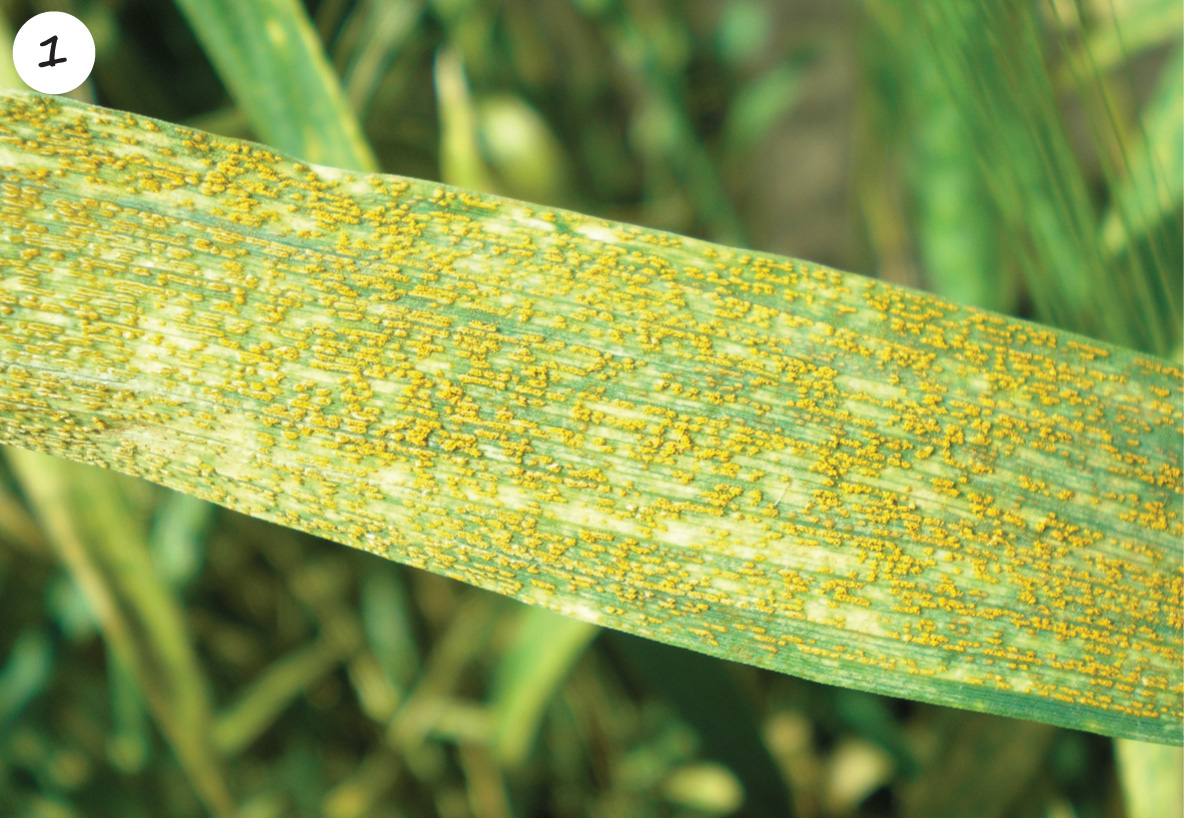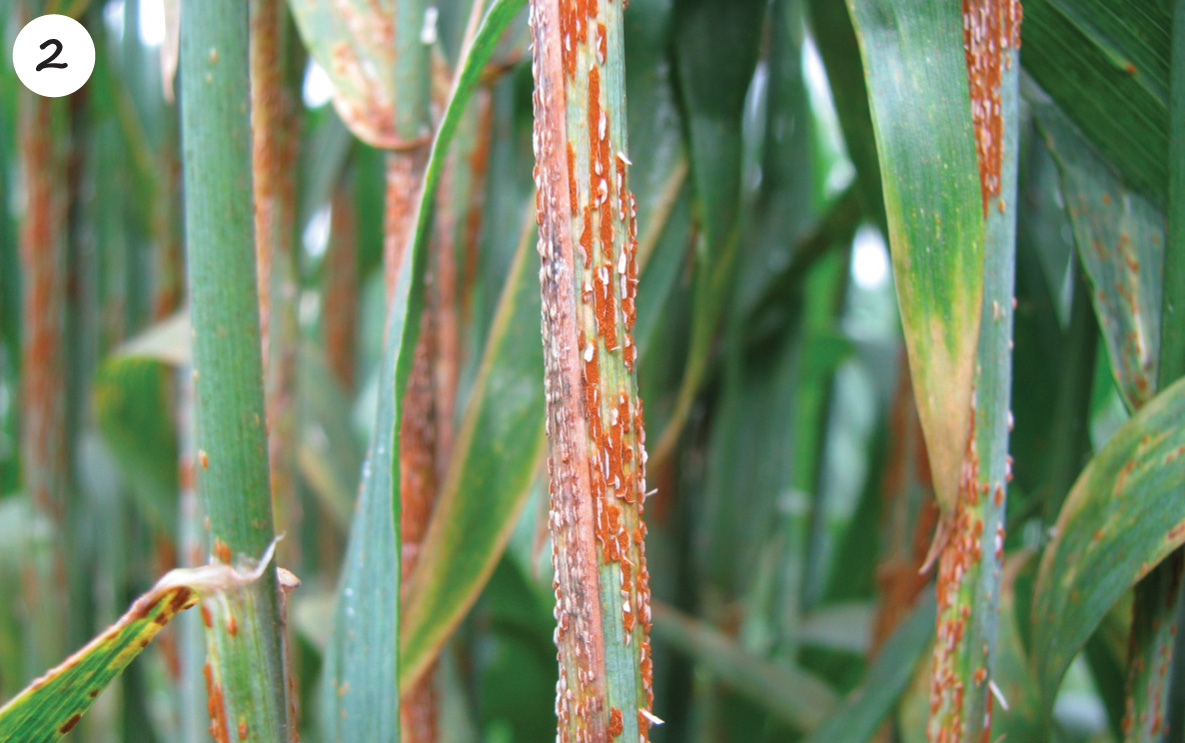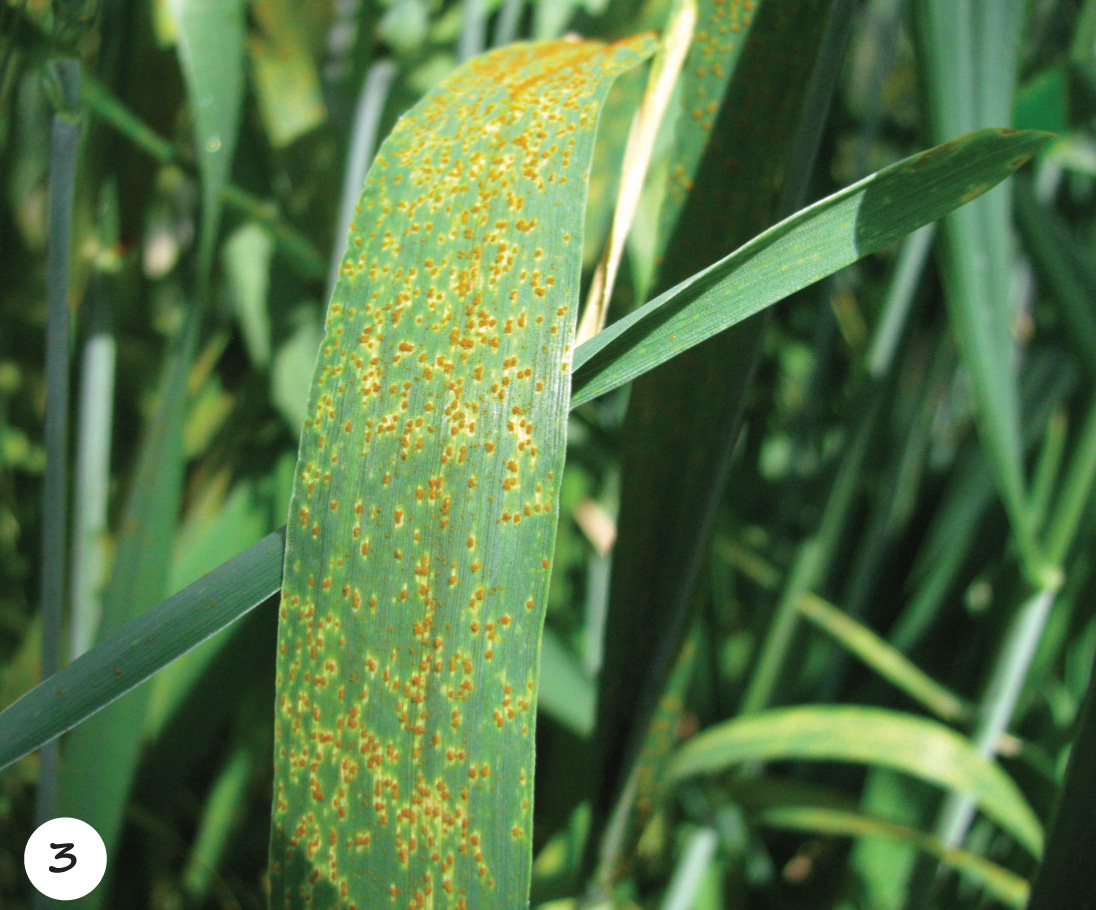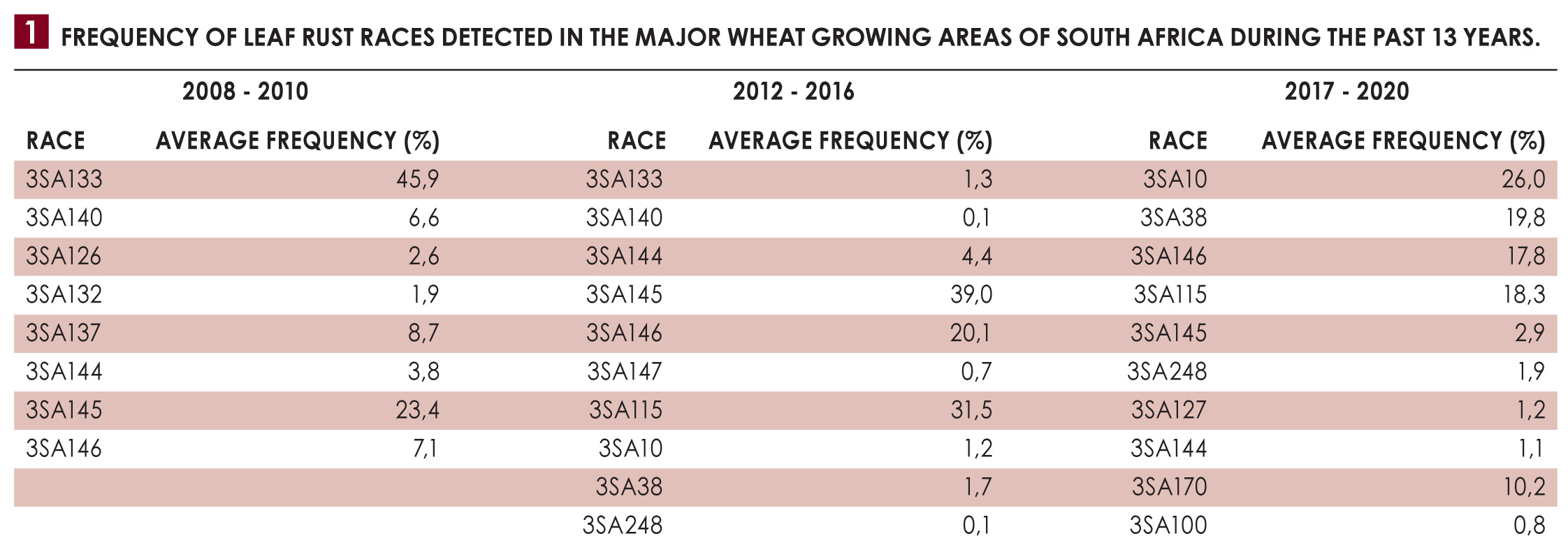
Rusts, which are caused by micro-organisms known as fungi, are devastating diseases of wheat worldwide. There are three kinds of rusts which commonly infect wheat in South Africa and globally. These are stem rust (black rust), leaf rust (brown rust) and stripe rust (yellow rust). These diseases differ in the colour and shape of pustules (masses of fungal spores) they produce on infected wheat and such symptoms are useful in the identification of the three rusts.
Stripe rust predominantly appears as yellow masses of spores arranged in stripes on the leaves (Photo 1), but can also occur on leaf sheaths, glumes and awns. Stem rust produces dark-red, elliptical pustules mainly on the stem of infected wheat, often coalescing and rupturing the plant epidermis (Photo 2). Leaf rust develops on leaves as circular to oval-shaped, orange-brown pustules (Photo 3). In South Africa, nearly 50% yield loss due to stem rust has been reported. Similarly, leaf and stripe rusts can cause more than 50% yield losses on susceptible cultivars. Therefore, proper crop protection practices should be implemented to minimise losses due to these diseases.


Photo: ZA Pretorius

Photo: ZA Pretorius
Resistant cultivars provide economical and environmentally friendly wheat rust control. The use of resistant cultivars will result in reduced application of fungicides, which translates to reduced environmental contamination and input costs as well as increased profitability. Resistance breeding is considered as an important wheat rust control strategy locally and in other wheat producing countries.
Wheat rust pathogens show pathogenic variability. In other words, the pathogen population usually contains a mixture of strains (races) which differ in their disease-causing ability against different resistance genes or wheat cultivars. Some of the existing rust races could gradually decrease and disappear from a specific wheat growing region(s). In contrast, new races can emerge anytime through mutations occurring in local rust populations or through exotic introductions into a specific region or country with the aid of their windborne spores or through human contact (clothes, shoes, etc.). As a result, the identity, frequency and distribution of rust races could vary between seasons and wheat growing areas.
Results
Table 1 illustrates the seasonal variability of leaf rust races detected in South Africa over 13 years. For example, eight races were identified during 2008 to 2010, but three of these (3SA126, 3SA132 and 3SA137) were not found since 2011. On the other hand, five new races (3SA147, 3SA115, 3SA10, 3SA38, 3SA248) were detected during 2012 to 2016, making the race composition in the later years significantly different from those detected from 2008 to 2010. Furthermore, three new races (3SA127, 3SA100 and 3SA170) were detected between 2017 and 2020.
 In addition to the changes in race composition over years shown in Table 1, the level of diversity in the pathogen population could vary between wheat growing regions. For example, there has usually been higher diversity of leaf rust and stem rust races in the Western Cape than in the remaining South African wheat growing regions. Occurrence of certain rust races can be limited to a specific region over many years. For example, 3SA146 (first detected in 2010) has been found in the summer rainfall regions, but it has never been detected in the Western Cape.
In addition to the changes in race composition over years shown in Table 1, the level of diversity in the pathogen population could vary between wheat growing regions. For example, there has usually been higher diversity of leaf rust and stem rust races in the Western Cape than in the remaining South African wheat growing regions. Occurrence of certain rust races can be limited to a specific region over many years. For example, 3SA146 (first detected in 2010) has been found in the summer rainfall regions, but it has never been detected in the Western Cape.
Similarly with stem rust, the Ug99-variant race 2SA107, which was first detected in 2009 in KwaZulu-Natal and later in the Free State, has not been detected in the Western Cape over the past 13 years. In contrast, the stem rust race 2SA106, which was first identified in 2007 in the Western Cape, has not been detected outside this province. Several factors control the occurrence and distribution of rust races. These include areas under production, genetics of the wheat cultivars, weather patterns, point of introduction of exotic isolates and survival of rust fungi during the off-season.
The results described above clearly demonstrate that wheat rust pathogens exhibit significant pathogenic variability over time and space. Such information should be seriously considered in rust resistance breeding. For effective resistance breeding, screening should be conducted in localities where there are high pathogenic diversities. Also, breeding materials need to be tested in the greenhouse using races that are present across the major production areas. Resistance sources tested in this way will result in cultivars with a broader range of rust resistance that will have improved durability. Data on pathogenic variability will also allow prediction of the responses of commercial wheat cultivars against different races. This information can be used by breeders and cultivar owners to decide on which cultivar to recommend in a specific production region. Knowledge of variation in rust fungi is thus essential for effective breeding and deployment of rust-resistant wheat cultivars.
Monitoring
Reliable information on pathogenic variability is obtained through constant monitoring (surveillance) of the rust pathogen population. ARC-Small Grain has been regularly monitoring the variability of all three types of wheat rusts over the past four decades. This rust monitoring project, in collaboration with other institutions such as the University of the Free State, regularly revealed the incidence and distribution of rust races across the major wheat production regions of the country. Rust pathogens continue to evolve and change their ability to infect different cultivars. Therefore, the annual rust surveillance being conducted by ARC-Small Grain and collaborators needs to be maintained as it is generating valuable information that will greatly support sustainable control of wheat rusts in South Africa.
ARC-Small Grain would like to take this opportunity to express its appreciation to SAWCIT (the South African Winter Cereal Industry Trust, formerly the Winter Cereal Trust) for understanding the importance of rust surveillance and continually funding the project over many years. Prof ZA Pretorius is acknowledged for editing the article.



























